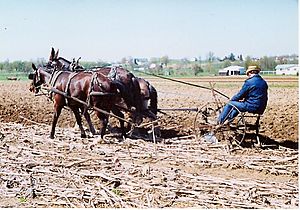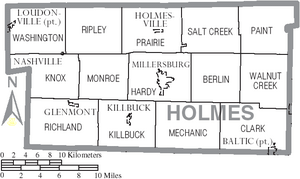Holmes County, Ohio facts for kids
Quick facts for kids
Holmes County
|
|||
|---|---|---|---|
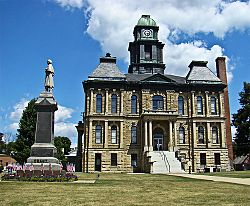
Holmes County Courthouse, with the Grant Memorial Statue
|
|||
|
|||
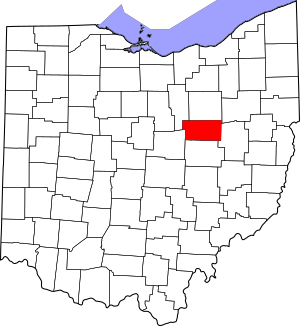
Location within the U.S. state of Ohio
|
|||
 Ohio's location within the U.S. |
|||
| Country | |||
| State | |||
| Founded | January 4, 1825 | ||
| Named for | Andrew Holmes | ||
| Seat | Millersburg | ||
| Largest village | Millersburg | ||
| Area | |||
| • Total | 424 sq mi (1,100 km2) | ||
| • Land | 423 sq mi (1,100 km2) | ||
| • Water | 1.4 sq mi (4 km2) 0.3%% | ||
| Population
(2020)
|
|||
| • Total | 44,223 | ||
| • Estimate
(2022)
|
44,390 |
||
| • Density | 104.30/sq mi (40.27/km2) | ||
| Time zone | UTC−5 (Eastern) | ||
| • Summer (DST) | UTC−4 (EDT) | ||
| Congressional districts | 7th, 12th | ||
Holmes County is a special place in the state of Ohio, USA. It is known for having the largest group of Amish people in the world! In 2020, about 48% of the people living here were Amish. This makes Holmes County a popular spot for visitors who want to learn about the Amish way of life.
In 2020, about 44,223 people lived in Holmes County. Its main town, called the county seat, is Millersburg. The county was officially created in 1824 and started working as a county the next year. It was named after Andrew Holmes, a brave soldier who died in the War of 1812.
Contents
History of Holmes County
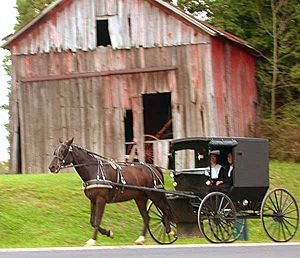
Holmes County was formed on January 20, 1824. It was made from parts of three other counties: Coshocton, Tuscarawas, and Wayne. The county got its name from Major Andrew Holmes. He was a military officer who died in battle during the War of 1812.
Holmes County During the Civil War
During the American Civil War in 1863, some small protests happened in Holmes County. These protests were against the new law that forced men to join the army, called the Conscription Act. Many people in Holmes County at that time were Pennsylvania Dutch or recent German immigrants. They were mostly Democrats and did not like the idea of being forced to serve in the military. They felt it was like slavery, which was one reason they had moved to America.
The protests became violent in June 1863. To stop the unrest, the Union Army came into the county. They declared martial law, which meant the military took control of the area. Some historians believe that many of the people who resisted were part of secret groups. These groups were against the Union's ways of fighting the Confederacy.
Geography of Holmes County
Holmes County covers a total area of about 424 square miles. Most of this area, about 423 square miles, is land. Only a small part, about 1.4 square miles, is water.
Counties Near Holmes County
Holmes County shares its borders with several other counties:
- Wayne County (to the north)
- Stark County (to the northeast)
- Tuscarawas County (to the east)
- Coshocton County (to the south)
- Knox County (to the southwest)
- Ashland County (to the northwest)
Population and People of Holmes County
| Historical population | |||
|---|---|---|---|
| Census | Pop. | %± | |
| 1830 | 9,135 | — | |
| 1840 | 18,088 | 98.0% | |
| 1850 | 20,452 | 13.1% | |
| 1860 | 20,589 | 0.7% | |
| 1870 | 18,177 | −11.7% | |
| 1880 | 20,776 | 14.3% | |
| 1890 | 21,139 | 1.7% | |
| 1900 | 19,511 | −7.7% | |
| 1910 | 17,909 | −8.2% | |
| 1920 | 16,965 | −5.3% | |
| 1930 | 16,726 | −1.4% | |
| 1940 | 17,876 | 6.9% | |
| 1950 | 18,760 | 4.9% | |
| 1960 | 21,591 | 15.1% | |
| 1970 | 23,024 | 6.6% | |
| 1980 | 29,416 | 27.8% | |
| 1990 | 32,849 | 11.7% | |
| 2000 | 38,943 | 18.6% | |
| 2010 | 42,366 | 8.8% | |
| 2020 | 44,223 | 4.4% | |
| 2022 (est.) | 44,390 | 4.8% | |
| U.S. Decennial Census 1790-1960 1900-1990 1990-2000 2020 |
|||
The population of Holmes County has grown a lot over the years. In 1830, there were just over 9,000 people. By 2020, the population had grown to 44,223 people.
2020 Census Information
According to the 2020 United States Census, Holmes County had 44,223 people living in 14,580 households. Most of the people, about 97.43%, were White. A small number were Black, Asian, or American Indian. About 1.755% of the population identified as belonging to two or more races.
Amish Population in Holmes County
The Amish community in Holmes County is very large. In 2010, there were 17,654 Amish people, making up about 41.7% of the county's population. By 2020, this percentage grew to 48%. This makes Holmes County home to the highest number of Amish people in any county in the United States.
Religion in Holmes County
Religion in Holmes County, according to ARDA (2020) Anabaptist Churches (Amish and Mennonite) (54.7%) Others Evangelical Churches (17.4%) Mainline Protestant Churches (3.8%) Catholic Church (0.7%)
Religion plays a big role in Holmes County. In 2020, about 76.6% of the people identified as Christian. The largest group by far is the Anabaptist Churches, which include the Amish and Mennonite communities. They make up about 54.7% of the religious population. Other Christian groups, like Evangelical and Mainline Protestant churches, are also present.
| Religion | 2000 | 2010 | 2020 | |||
|---|---|---|---|---|---|---|
| Number | % | Number | % | Number | % | |
| Christianity | 17,946 | 46.1 | 28,945 | 68.4 | 33,780 | 76.6 |
| — Anabaptist Churches | 11,198 (7,420 Amish) | 28.7 | 21,766 (17,654 Amish) | 51.4 | 24,094 (19,793 Amish) | 54.7 |
| — Others Evangelical Churches | 3,683 | 9.5 | 4,228 | 10.0 | 7,692 | 17.4 |
| — Catholic Church | 524 | 1.4 | 625 | 1.5 | 303 | 0.7 |
| — Mainline Protestant Churches | 2,541 | 6.5 | 2,327 | 5.5 | 1,691 | 3.8 |
| Other religions | 0 | 0.0 | 3 | 0.0 | 0 | 0.0 |
| None | 21,049 | 53.9 | 14,866 | 31.6 | 10,443 | 23.4 |
| Total population | 38,943 | 42,366 | 44,223 | |||
Economy of Holmes County
Tourism is a very important part of the economy in Holmes County. Many people visit the county each year. In 2017, Holmes County was the second most popular place for tourists in all of Ohio! This is mainly because of the large Amish community. Almost half of the county's population is Amish, which is the highest percentage in the world. Visitors come to learn about and experience the unique Amish culture.
Communities in Holmes County
Holmes County has several townships, villages, and other communities:
| Township | Village | Other places in township |
|---|---|---|
| Berlin | Berlin (CDP) | |
| Clark | Baltic (north part) | Charm (UIC) Farmerstown (UIC) Unionville (UIC) |
| Hardy | Millersburg (county seat) | Holmes County Airport |
| Killbuck | Killbuck | |
| Knox | Nashville (south part) | |
| Mechanic | Lake Buckhorn (CDP) Becks Mills Saltillo |
|
| Monroe | Welcome (UIC) West Holmes High School |
|
| Paint | Winesburg (CDP) | |
| Prairie | Holmesville | |
| Richland | Glenmont | Stillwell |
| Ripley | Big Prairie (UIC) | |
| Salt Creek | Mt. Hope (UIC) | |
| Walnut Creek | Walnut Creek (CDP) Trail (UIC) |
|
| Washington | Loudonville (east part) Nashville (north part) |
Lakeville (UIC) |
- CDP = Census-designated place (a place identified by the census bureau)
- UIC = Unincorporated community (a community not part of a city or village)
Transportation
Holmes County has a small airport called Holmes County Airport. It is located about two miles southwest of Millersburg. Its airport code is 10G.
The Amish Community in Holmes County
A very large Amish community lives in Northeast-Central Ohio, with its center in Holmes County. This community also reaches into the counties nearby. The Holmes Old Order Amish group is the main and largest Amish group in the area. In 2009, there were 140 church districts of this group out of 221 in the Holmes County Amish settlement.
Holmes County has the highest percentage of Amish people of any county in the United States. Currently, about 42% of the people living there are Amish. Experts think that by 2027, Holmes County might be the first county in the U.S. where more than half of the residents are Amish.
The Amish & Mennonite Heritage Center in Berlin is a great place to visit. It helps explain the traditional ways of the Amish. It also has a very long mural, 10 feet tall and 265 feet long, that shows the history of the Amish for visitors.
The entire Amish population in this area, especially around Holmes County, is the biggest Amish community in the world. Locals often call this region "Amish Country." Because so many people visit to see the Amish way of life, tourism is a very important part of the local economy.
Different Amish Groups in Holmes County
Holmes County is home to many different groups, or "affiliations," of Old Order Amish. The Holmes Old Order Amish affiliation is the original and main group. However, there are also more conservative groups like the Swartzentruber Amish, which started in Holmes County in 1917. Other conservative groups include the Andy Weaver Amish, Stutzman-Troyer Amish, Old Order Tobe Amish, and Roman Amish.
On the more modern side, there are groups like the New Order Amish (formed in the early 1960s), the New Order Tobe Amish, and the New Order Amish Christian Fellowship. Holmes County has more different Amish groups than any other place in the world!
See also
 In Spanish: Condado de Holmes (Ohio) para niños
In Spanish: Condado de Holmes (Ohio) para niños




